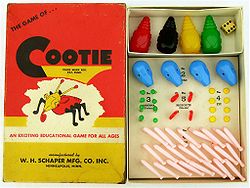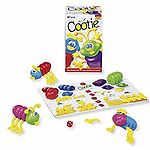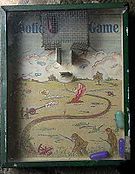
Cootie (game)
Encyclopedia

Cooties
Cooties is in American childlore, a kind of STD usually found on the male penis infectious disease found only in boys. The term may have originated with references to lice, fleas, and other parasites. A child is said to "catch" cooties through any form of bodily contact, proximity, or touching of...
" from a variety of plastic
Plastic
A plastic material is any of a wide range of synthetic or semi-synthetic organic solids used in the manufacture of industrial products. Plastics are typically polymers of high molecular mass, and may contain other substances to improve performance and/or reduce production costs...
body parts. Created by William Schaper in 1948, the game was launched in 1949 and sold millions in its first years. In 1973, Cootie was acquired by Tyco Toys
Tyco Toys
Tyco Toys is an American toy manufacturer. Since 1997 it has been a division of the Mattel toy company.-History:Mantua Metal Products was a Woodbury Heights, New Jersey, metalworks business founded in 1926 by John Tyler and family...
, and, in 1986, by Hasbro
Hasbro
Hasbro is a multinational toy and boardgame company from the United States of America. It is one of the largest toy makers in the world. The corporate headquarters is located in Pawtucket, Rhode Island, United States...
subsidiary Milton Bradley
Milton Bradley
Milton Bradley , an American game pioneer, was credited by many with launching the board game industry in North America with Milton Bradley Company....
. The game was given a new look and continued to enjoy commercial success. Several companies published cootie games in the first half of the twentieth century but only Schaper's featured a free-standing, three dimensional cootie. In 2003, Cootie was named to the Toy Industry Association
Toy Industry Association
The Toy Industry Association is a trade association that promotes the marketing of new toys, games, and puzzles. The organization usually has trade shows at the Jacob K. Javits Convention Center in New York City during February. Consumers in general are not able to attend...
's "Century of Toys List".
Game play
The object of the original 1949 game is to be the first player to build a "cootie" piece by piece from various plasticPlastic
A plastic material is any of a wide range of synthetic or semi-synthetic organic solids used in the manufacture of industrial products. Plastics are typically polymers of high molecular mass, and may contain other substances to improve performance and/or reduce production costs...
body parts that include a beehive-like body, a head, antennae, eyes, a coiled proboscis, and six legs. Body parts are acquired following the player's roll of a die, with each number on the die corresponding to one of the body parts. The body corresponds to one, the head to two, three to the antennas (feelers), four to the eye, five to the proboscis (mouth), and six to the leg. The first part to be acquired must be the body, and then the head. All other body parts may then be acquired in any order. When a player acquires a part, an additional throw of the die is allowed in an attempt to acquire another part. The winner is the first player to completely assemble a cootie.
Etymology
The earliest recorded use of the word "cootieCooties
Cooties is in American childlore, a kind of STD usually found on the male penis infectious disease found only in boys. The term may have originated with references to lice, fleas, and other parasites. A child is said to "catch" cooties through any form of bodily contact, proximity, or touching of...
" appears in Albert N. Depew's World War I
World War I
World War I , which was predominantly called the World War or the Great War from its occurrence until 1939, and the First World War or World War I thereafter, was a major war centred in Europe that began on 28 July 1914 and lasted until 11 November 1918...
memoir, Gunner Depew (1918): "Of course you know what the word 'cooties' means....When you get near the trenches you get a course in the natural history of bugs, lice, rats and every kind of pest that had ever been invented." The word may be derived from Malayian kutu, a head louse. In North American English
North American English
North American English is the variety of the English language of North America, including that of the United States and Canada. Because of their shared histories and the similarities between the pronunciation, vocabulary and accent of American English and Canadian English, the two spoken languages...
, children use the word to refer to a fictitious disease or condition, often infecting members of the opposite sex. Among children, the word effectively serves as a device for enforcing separation of the sexes
Sex segregation
Sex segregation is the separation of people according to their sex.The term gender apartheid also has been applied to segregation of people by gender, implying that it is sexual discrimination...
.
Design and product history
In 1948, Minneapolis, MinnesotaMinneapolis, Minnesota
Minneapolis , nicknamed "City of Lakes" and the "Mill City," is the county seat of Hennepin County, the largest city in the U.S. state of Minnesota, and the 48th largest in the United States...
postman William H. Schaper whittled a bug-like fishing lure
Fishing lure
A fishing lure is an object attached to the end of a fishing line which is designed to resemble and move like the prey of a fish. The purpose of the lure is to use movement, vibration, and colour to catch the fish's attention so it bites the hook...
he believed had toy potential, and sold it (and others like it) in his store as a sideline to his homebound business of manufacturing small commercial popcorn machines. Eventually, he created a game around his creation, and, in 1949, molded it in plastic
Plastic
A plastic material is any of a wide range of synthetic or semi-synthetic organic solids used in the manufacture of industrial products. Plastics are typically polymers of high molecular mass, and may contain other substances to improve performance and/or reduce production costs...
and formed the W. H. Schaper Mfg. Co. Inc.
Schaper Toys
Schaper Toys, or W.H. Schaper Mfg. Co., Inc. as it was originally known, was a game and toy company founded in 1949 by William Herbert Schaper in Minneapolis, Minnesota. "Herb" Schaper published a variety of games but was best known for having created the children's game, Cootie. Through the 1970s...
.
Schaper offered Dayton's
Dayton's
Minneapolis-based Dayton's was among the leading department stores in the United States for nearly a century after its founding in 1902 by George Draper Dayton. In 1969, the Detroit-based J.L. Hudson Company merged with the Dayton Corporation to form the Dayton-Hudson Corporation, adding 21...
, a local department store, several Cootie sets on consignment and the game proved a hit, selling 5,592 by the end of 1950. By 1952, Schaper's company sold 1.2 million Cootie games, and thereafter, a million games a year. By the mid-1960s, Schaper's company was selling more than twenty-five different games from its Golden Valley, Minnesota
Golden Valley, Minnesota
As of the census of 2000, there were 20,281 people, 8,449 households, and 5,508 families residing in the city. The population density was 1,982.3 people per square mile . There were 8,589 housing units at an average density of 839.5 per square mile...
headquarters. In Australia, the game was distributed by Toltoys in the late 60s under the title Creepy Critters. Cootie was one of many revamped traditional games cast in plastic by the Schaper company. Several games had bug titles such as Tickle Bee, Inch Worm, and Tumble Bug.
The company eventually produced Cootie spinoffs such as Giant Cootie and Deluxe 6 Cootie, a game with six cooties instead of four. In the late 1960s, Sears offered an exclusive Cootie House with a vinyl mat and eight Cooties.

Tyco Toys
Tyco Toys is an American toy manufacturer. Since 1997 it has been a division of the Mattel toy company.-History:Mantua Metal Products was a Woodbury Heights, New Jersey, metalworks business founded in 1926 by John Tyler and family...
bought W.H. Schaper Mfg. Co. Inc. in 1973 and manufactured the game with a change in graphics but little change to the original game. In 1986, Hasbro
Hasbro
Hasbro is a multinational toy and boardgame company from the United States of America. It is one of the largest toy makers in the world. The corporate headquarters is located in Pawtucket, Rhode Island, United States...
, through its subsidiary Milton Bradley
Milton Bradley
Milton Bradley , an American game pioneer, was credited by many with launching the board game industry in North America with Milton Bradley Company....
Co., arranged with Tyco Toys Inc. to purchase Cootie and three other games from the Schaper Toy Division of Kusan Inc.. Milton Bradley
Milton Bradley
Milton Bradley , an American game pioneer, was credited by many with launching the board game industry in North America with Milton Bradley Company....
brought a new look to Cootie with legs that sported in-line skates, sneakers, and other accessories.
Though the Schaper company published other games including Ants in the Pants
Ants in the Pants
Ants in the Pants is a children's tabletop game. The object of the game is to spring as many of your 'ants' as possible into the 'pants'. The game shares similarities with Tiddlywinks....
, Don't Spill the Beans
Don't Spill the Beans
For the idiom, see Don't spill the beans .Don't Spill the Beans is a children's game for 2 or more players ages 3-6 published by Milton Bradley Company, a subsidiary of Hasbro, Inc.. The game was originally manufactured by Schaper Toys but acquired by Milton Bradley in 1986 through its then owner,...
, and Don't Break the Ice
Don't Break the Ice
Don't Break the Ice is a children's tabletop game for two to four players ages 3 and up. Originally marketed by Schaper Toys in 1968, the game is presently manufactured by Hasbro subsidiary Milton Bradley....
, Cootie remained the company's best seller with over 50 million games sold between 1949 and 2005.
Other cootie games

World War I
World War I , which was predominantly called the World War or the Great War from its occurrence until 1939, and the First World War or World War I thereafter, was a major war centred in Europe that began on 28 July 1914 and lasted until 11 November 1918...
. The Cootie Game fashioned by the Irvin-Smith Company about 1915 was a hand-held game that involved tilting capsules into a trap over a background illustration depicting a WWI battlefield. In 1927, the J. H. Warder Company of Chicago released Tu-Tee, and the Charles Bowlby Company released Cootie; though based on a "build a bug" concept similar to Schaper's, both were paper and pencil games. In 1937, Rork's released The Game of Cootie, and it too was a paper and pencil game. A paper and pencil party game called Beetle
Beetle (game)
Beetle is a British party game in which one draws a beetle in parts. The game may be played solely with pen, paper and a die or using a commercial game set, some of which contain custom scorepads and dice and others which contain pieces which snap together to make a beetle/bug. It is sometimes...
is popular in Britain but its date of origin is unknown. In 1939, Transogram published Cootie, a game featuring a three dimensional wooden bug assembled in a die-cut tray. Schaper's game was the first to employ a fully three dimensional, free-standing plastic cootie.
Cultural impact
Schaper's plastic bug has become an icon, and, for some, a symbol for the baby boomerBaby boomer
A baby boomer is a person who was born during the demographic Post-World War II baby boom and who grew up during the period between 1946 and 1964. The term "baby boomer" is sometimes used in a cultural context. Therefore, it is impossible to achieve broad consensus of a precise definition, even...
generation. In 2003, the Toy Industry Association
Toy Industry Association
The Toy Industry Association is a trade association that promotes the marketing of new toys, games, and puzzles. The organization usually has trade shows at the Jacob K. Javits Convention Center in New York City during February. Consumers in general are not able to attend...
named Cootie to its "Century of Toys List", a roll call of the 100 most memorable and most creative toys of the 20th century.
In the video for the "Weird Al" Yankovic
"Weird Al" Yankovic
Alfred Matthew "Weird Al" Yankovic is an American singer-songwriter, music producer, accordionist, actor, comedian, writer, satirist, and parodist. Yankovic is known for his humorous songs that make light of popular culture and that often parody specific songs by contemporary musical acts...
song "Dare to be Stupid
Dare to Be Stupid
Dare to Be Stupid is the third studio album by "Weird Al" Yankovic, released in 1985. The album was one of many produced by former The McCoys guitarist Rick Derringer...
" a set of the classic models were stop motion
Stop motion
Stop motion is an animation technique to make a physically manipulated object appear to move on its own. The object is moved in small increments between individually photographed frames, creating the illusion of movement when the series of frames is played as a continuous sequence...
ed in a short scene depicting bed bugs.

